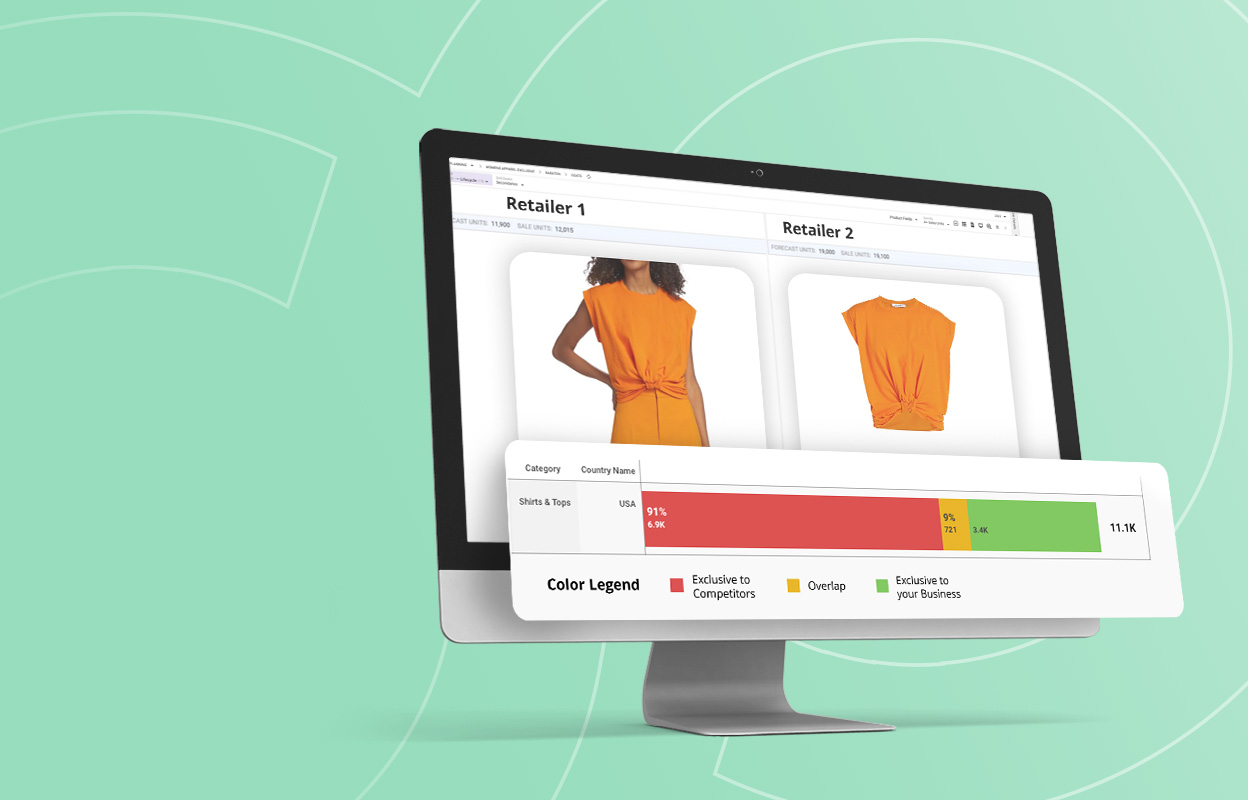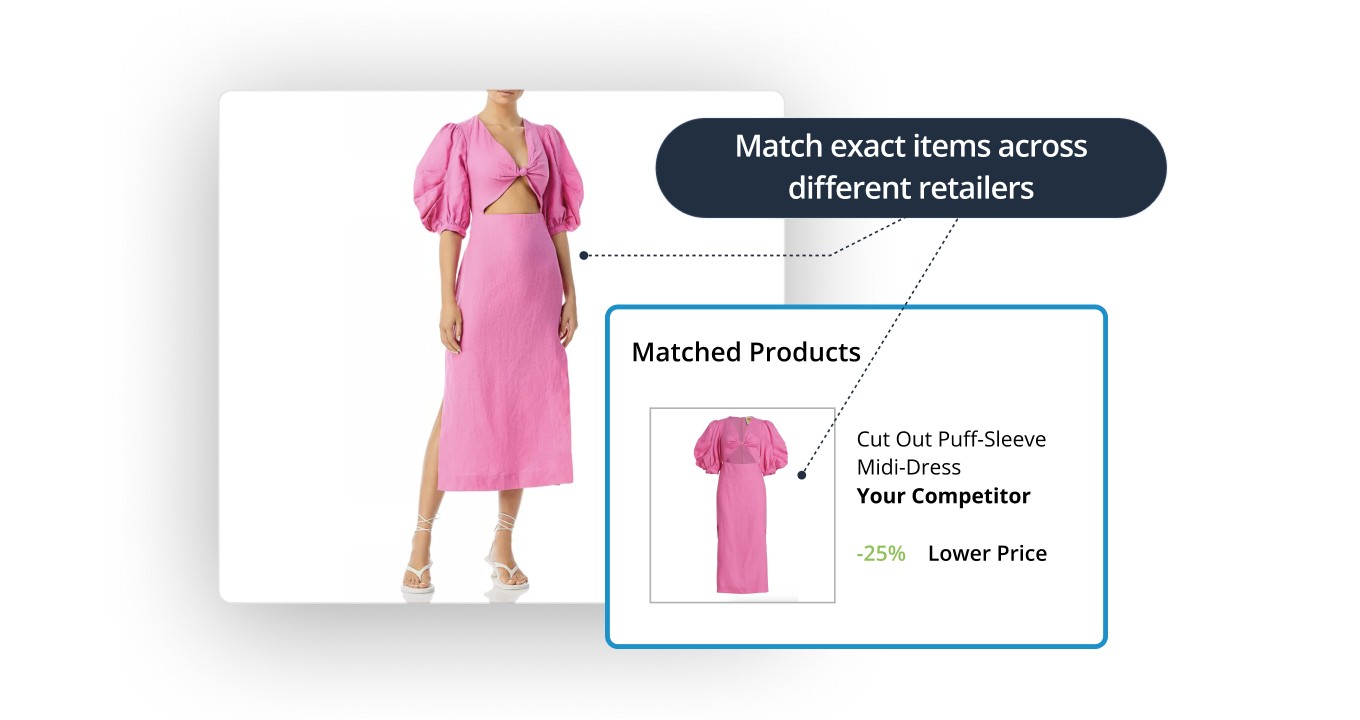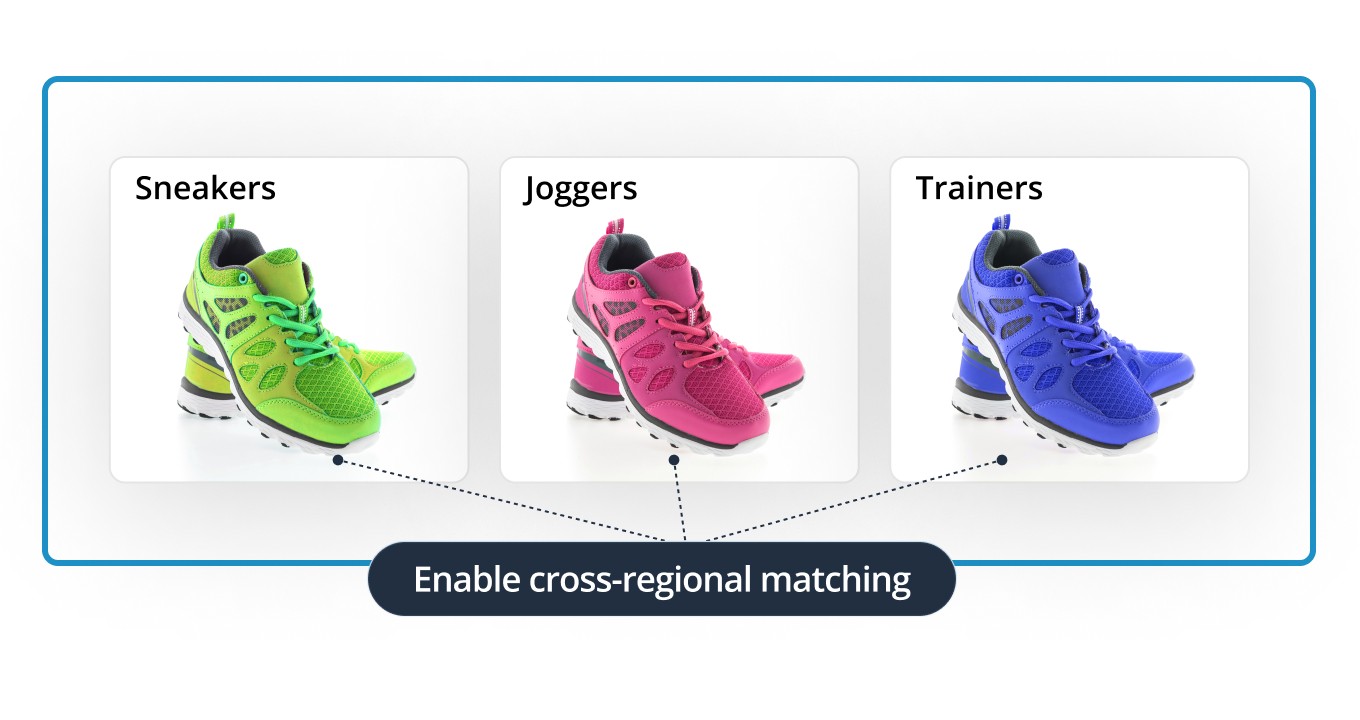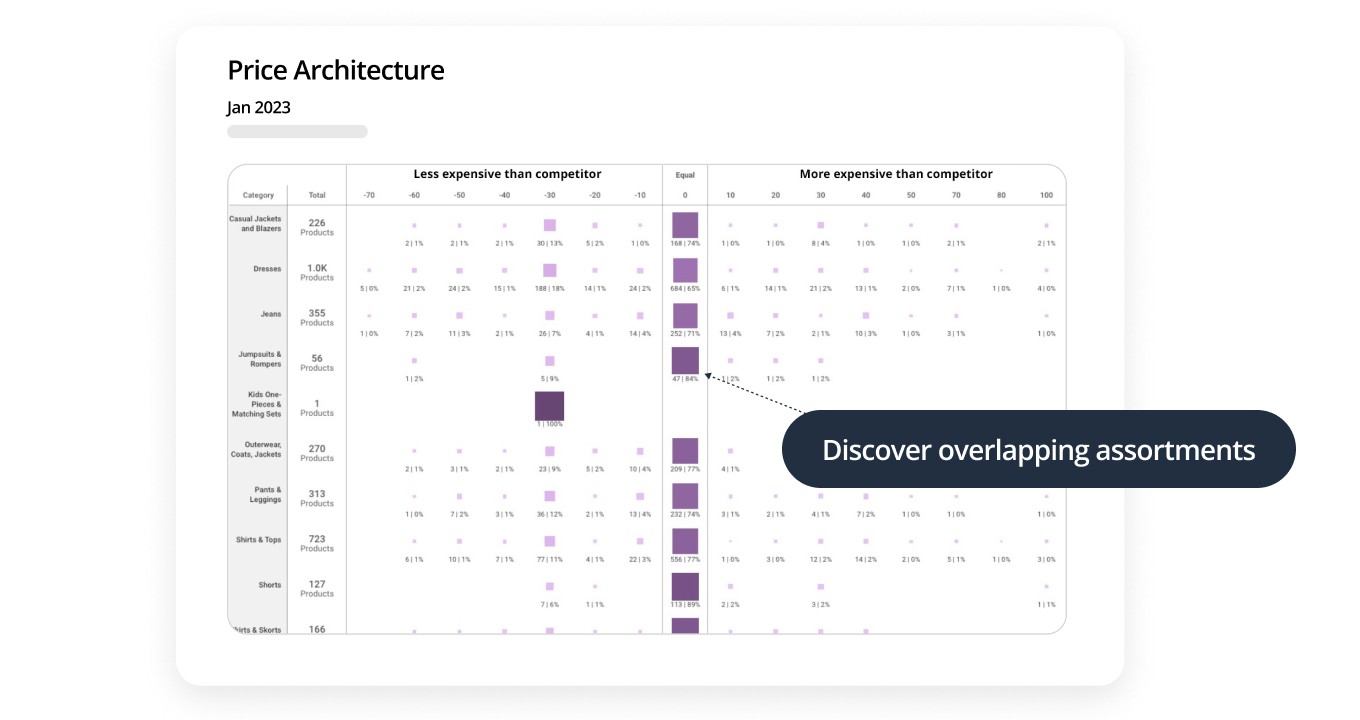Product Matching in Fashion and Footwear: Use and Benefits

Product matching is a game-changing process that leverages machine learning image recognition technology to effectively match exact products. Its capabilities are hugely beneficial within the fast-paced world of fashion eCommerce, thanks to the speed at which fashion items can be uploaded, promoted and discounted. Manually collecting and matching exact products across competitors and their fluctuating prices is a painstaking process that doesn’t align well with the rapid needs of the fashion industry. Read on to learn what product matching software is, and how it’s enabling businesses to stay competitive and efficient in the ever-changing eCommerce landscape.
For multi-brand retailers who are selling the exact same items, reliable product matching is essential. For example, if you’re selling a pair of Levi’s jeans, you need to know what your competitor is selling the same pair for and when it’s being discounted so your pricing remains competitive. Product matching in eCommerce is also useful for buyers and merchandisers to understand what percent of their assortment overlaps with a competitor, and when they might need to challenge suppliers for exclusive collections.
What is Product Matching?
Product matching in eCommerce is the process of matching identical products. The process can be done either manually or through deep learning technologies which provides a deeper understanding of both a business’s product mix as well as those of its competitors. This information can then be used for price benchmarking, pricing adjustments, range rationalization and general competitor intelligence.
Today, machine learning image recognition technology can automatically identify and match identical products based on various factors, such as visual attributes, product titles, descriptions and prices. This specialized product matching software uses advanced algorithms to analyze and compare product data, enabling a business to efficiently match products in the eCommerce landscape.

What is the Purpose of Product Matching?
Matching exact products is one essential piece in the bigger picture of pricing intelligence and an integral part of a comprehensive competitive benchmarking strategy.
For multi-brand retailers, their assortment is made up of a range of various brands with those same brands sold in another retailer in the same competitive space. With hundreds of exact products being sold in both stores, it becomes an exponentially impossible task to match, compare and track these products without human error or insane amounts of time. But knowing which parts of your assortment are overlapping with your competitors (down to the exact categories, brands and SKUs), at what price they’re selling those items at and when they’re discounting them are crucial questions you must be able to ask and answer to stay competitive.
What Challenges Does a Fashion Product Matching Solution Solve?
It’s surprising that some retailers still rely on manual ways to match products without advanced software assistance. This way might seem acceptable if it’s all a business has ever known, that is until you consider all the failure points of such an approach. Consider the heterogeneous product descriptions across different sites that include abbreviations, sizes and synonyms that make it difficult to accurately match products. From just a single photo of a blouse online, can you accurately tell what types of buttons or closures it features? And what material are they made of?
That’s just one example of the nearly infinite number of details that need to be considered when attempting to manually product match. You then need to be able to track pricing over time to understand which exact items to discount, and when. During peak shopping days like Black Friday or Cyber Monday, prices fluctuate so much in such a short period of time, it’s vital that the tool you use provides intra-daily crawling. With manual matching, the margin for human error is obvious to see. This doesn’t even account for how labor-intensive and time-consuming it is, resources that could be better allocated to tasks that demand human insight.
A product matching solution streamlines the process of identifying and matching exact products in the e-commerce landscape. Without product matching tools, businesses may face several challenges, such as out-of-sync pricing or the lack of a unique offering for consumers. For eCommerce retailers, product matching is a significant part of their overall strategy for competitive benchmarking, as it enables them to stay aware of what is happening in the market and make informed assortment decisions and pricing adjustments that are based on accurate data. By leveraging product matching AI software, businesses can automate the process of matching products, saving time and resources, reducing errors, and ensuring exact products are accurately matched, even when dealing with diverse product descriptions, different imagery, color or attribute variations across different sites or platforms.
How Does Product Matching with Machine Learning Work?
One common limitation of product matching without the help of technology is firstly that Google Shopping (or similar marketplaces) don’t carry the full assortment. Manually trying to match products this way will not result in an accurate assortment analysis.
Another challenge is that several product matching providers within the fashion industry use code-based matching, and although this is a cheaper and easier setup, it also misses a significant part of the assortment as many fashion products are missing these codes.
AI Product matching tools look at various data points, some of these include:
- Titles and product descriptions
- Imagery
- Color
- Sizing
- Product attributes (print, neckline, sleeve length)
- Unique product codes (UPC, GTIN, MPN)
Differing product titles or descriptions due to international variations in product naming conventions, such as “trainers” in the UK, “sneakers” in the US, or “joggers” in Australia can pose difficulty in product matching. However, machine learning algorithms can be trained to recognize and map these different terms to a unified product category or type, enabling cross-region matching.
Another difficulty is handling product images taken on different models with varying descriptions and titles, this also might include brand abbreviations like DKNY or Donna Karen New York for instance. Machine learning algorithms can analyze image features, such as color, shape, and pattern to identify and match exact products.
Not all software is created equal; the higher the recall and precision rate, the more accurate the system’s ability to match products. These tools are powered by advanced image recognition, natural language processing, and data analysis to identify and compare product information, enabling accurate matching even when product names, pictures or descriptions may differ. Centric Market Intelligence™, for instance, can match products against any retailer in the full assortment, with a 99% precision rate.

What Are the Benefits of Product Matching in eCommerce?
The benefits for multi-brand retailers range from greater visibility into overlapping assortments with competitors allowing for better optimization of product assortments, to keeping up with pricing and discounting of all matched products.
Understand Exactly What Your Competitors Are Selling
Do you know how much overlap your assortments currently have with your competitors, and at what level – category, subcategory or brand? Leverage this data to uncover the product strategies of your competitors. To effectively compete with similar retailers, you need a deep understanding of their collections so you can offer something unique and exclusive to your customers.
Allows for More Competitive Pricing
Product matching is a key part of gaining greater competitive pricing intelligence, this is especially important as more and more consumers are shopping comparatively. Being able to accurately match products across your competitors, and track those products over time, enables you to quickly understand if you are pricing higher or lower than competitors. Keeping tabs on when and how those items are discounted also allows you to know when to adjust your own pricing strategy to entice customers to buy from your store.
This type of insight is only effective when it is accurately based on high-quality product matching. Poor product matching data can cause pricing decisions to be flawed which can result in costly pricing adjustments.

What to Look for in Product Matching Solution?
There are many providers out there – where the data quality and ability to match exact products can differ greatly. Investing in the right solution and vendor is an important first step.
Exact matching starts with precision and accuracy. As you’re aware, in fashion and footwear there are a significant number of knockoff pieces. The precise matching of the same SKU is incredibly important to prevent an issue for instance where you accidentally match with knock-off items and discount erroneously. Imagine discounting a $400 jacket because you’ve incorrectly matched your item to a knock off product, one that is on that sale for a quarter of the price. Or incorrectly matching a satin dress to a polyester dress and then blindly adjusting the price of the satin dress is a very expensive mistake! Pick a software provider who invests heavily in QA processes to achieve high precision rates, like Centric Market Intelligence, so you can work, analyze and adjust pricing on data you can trust.
To ensure data quality, the data you’re working from must be crawled every day. For instance, Centric Market Intelligence updates its data every 12-34 hours. It’s best to dig into the details of your matching software, because not all software crawls this often and it’s a crucial component of product matching, especially during those critical peak shopping periods. In addition, high quality data requires transparency and the ability to verify back to its source.
Is it Time to Invest in Product Matching Tools?
- Do you have a 360-degree view of the exact products that you and your competitors are selling?
- Are you easily able to identify those overlapping items and keep track of their price?
- Do you know where the growth opportunities are in your assortment?
- Or where you might need to differentiate from competitors and offer something unique?
If you cannot quickly and efficiently answer these questions, then it’s time to invest in product matching tools.
Discover more about Centric Market Intelligence, a comprehensive AI-powered tool that provides product matching and pricing intelligence, competitor benchmarking and trend forecasting for the fashion, footwear, beauty and homeware industries.








